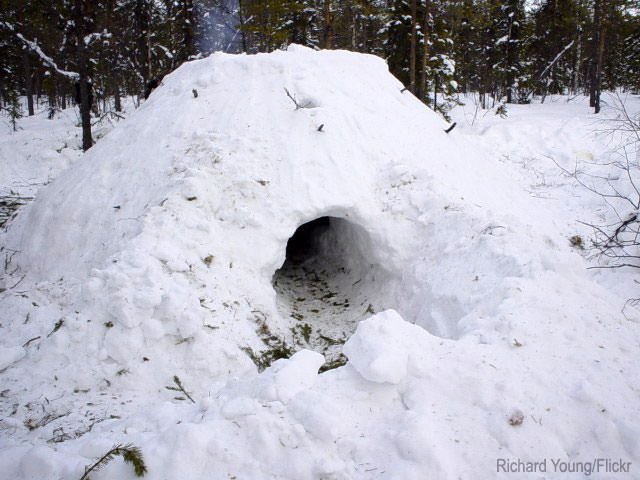
 Courtesy Richard Young/Flickr |
Last week, when Mom was feeding us, she looked around at all the snow from our first snowstorm of the year and said, “Martok, I should have built a quinzee before the snow started to melt.” Uzzi and I looked at each other. A quinzee—what’s that? So after the lights went out that night, Uzzi and I crept in the house and booted up the computer. Here’s what we found out.
A quinzee is a winter camping shelter made by hollowing out a pile of settled snow. Mom says it’s hard but fun work to make one, and it’s surprisingly warm to sleep in, even on the coldest nights.
To build a two-person quinzee, you need a lot of snow and a level spot away from trees and snowmobile traffic. Don’t place a quinzee where humans or animals might walk over the top.
Here’s what you’ll need to get started building the quinzee:
- at least a dozen 15-inch sticks
- a rope or stick 4½ feet long
- two kinds of shovels (a big one for piling and a small one for hollowing out the quinzee mound)
- at least two people
To start, stand in the middle of the area holding one end of the rope or stick while another person holds the other end and walks in a circle to mark the circumference of the mound. Pile snow inside the circle, mixing it together as you work. Mixing is important because it introduces snow of slightly different temperatures to aid the sintering (settling and hardening) process. Just pile it; don’t pack it down.
When you have a mound about 6 feet high, insert your 15-inch sticks about 18 inches up from the bottom of the mound at 1-foot intervals. Push them all the way in. These will guide you as you hollow out the mound, to make sure your walls are at least 15 inches thick.
Wait at least two hours for the snow to sinter. Don’t rush this important step! The colder it is, the quicker snow hardens so if it’s not particularly cold, give it extra time.
After sintering, your mound is ready to excavate. Use your small shovel to dig an entrance. Place the entrance on the side opposite of your prevailing wind. Dig in, scrape to one side, and then scrape up. This makes the quinzee stronger and helps prevent cold air from seeping in through the entrance while you’re camping. One person should while the other hauls snow away. As the digger reaches the 15-inch guide sticks, it’s wise to move the sticks up the sides of the quinzee to make certain no part of the wall is dug out too thin. When the mound is hollowed out to the depth of the guide sticks, smooth the interior with your hands to minimize dripping.
Now, either enlarge the holes made by your guide sticks or poke some ventilation holes through the walls. Also use a tarp as a ground cloth to help keep you warm.
Some online guides say you can cook inside a quinzee, but don’t do it! If you do, carbon dioxide can build up inside the quinzee and poison you while you sleep.
If you’d like, use snow to build two sleeping platforms inside the quinzee. When using the quinzee, make certain ventilation holes don’t get covered up with ice and snow. Use your backpacks to semi-block the entrance while you’re inside. Add winter sleeping bags and you’re ready to camp. A quinzee is warmer than any tent!
Before you build your first quinzee, watch this cool video created by Scouts Canada. These kids know how it’s done!
Winter camping in a quinzee sounds fun (for humans, not goats!), but if you do it, stay safe. Place poles with streamers outside the entrance so that no one accidentally walks or snowmobiles over the mound while there are people inside. Take your small shovel inside, and keep it there in case you have to dig your way out. Sleep with your face near a ventilation hole and don’t completely block the entrance with a pack or anything else. You need some air to breathe.
Ask Martok!
Do you have a livestock or wildlife question you want me to answer? Send me your question!
Please keep in mind that I receive a lot of questions, so I won’t always be able to answer each one immediately. In the case of an animal emergency, it’s important to reach out to your veterinarian or extension agent first.




